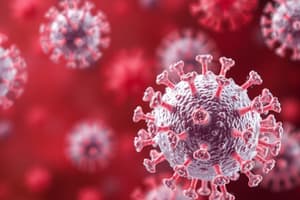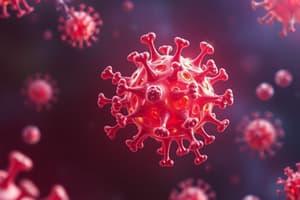Podcast
Questions and Answers
Which characteristic distinguishes idiotypes from other types of antibody variations?
Which characteristic distinguishes idiotypes from other types of antibody variations?
- They are defined by variations in antigen-binding specificity. (correct)
- They are restricted to IgG, IgM, IgA, IgE, and IgD isotypes.
- They are present in all members of a species.
- They involve variations in the constant region of the antibody.
How does the alternative complement pathway differ from the classical pathway in its activation mechanism?
How does the alternative complement pathway differ from the classical pathway in its activation mechanism?
- It requires the presence of Ca²+ and Mg²⁺ ions for activation.
- It is initiated by high molecular weight polysaccharides and lipopolysaccharides on target cell surfaces. (correct)
- It involves the attachment of plasma Mannose-Binding Lectin (MBL) to activate proteins.
- It is activated by the formation of antigen-antibody complexes with IgM.
What is the primary functional consequence of the formation of the membrane attack complex (MAC)?
What is the primary functional consequence of the formation of the membrane attack complex (MAC)?
- Formation of transmembrane pores leading to osmotic lysis and cell death. (correct)
- Opsonization of pathogens to enhance phagocytosis.
- Inhibition of complement activation via regulatory proteins.
- Stimulation of inflammation through peptide fragment split products.
Why do IgG antibodies against the Rh antigen typically fail to efficiently bind and activate the complement system?
Why do IgG antibodies against the Rh antigen typically fail to efficiently bind and activate the complement system?
What is the immediate consequence of C1 binding to two adjacent Ig Fc regions on a target cell?
What is the immediate consequence of C1 binding to two adjacent Ig Fc regions on a target cell?
How does the chemical complexity of an antigen typically influence the immune response it elicits?
How does the chemical complexity of an antigen typically influence the immune response it elicits?
In the context of blood group antibodies, what is the key distinction between naturally occurring and immune antibodies?
In the context of blood group antibodies, what is the key distinction between naturally occurring and immune antibodies?
Why are monoclonal antibodies often preferred over polyclonal antibodies in diagnostic testing?
Why are monoclonal antibodies often preferred over polyclonal antibodies in diagnostic testing?
How does the molecular weight of an antigen influence its immunogenicity, according to the text?
How does the molecular weight of an antigen influence its immunogenicity, according to the text?
What distinguishes alloantibodies from autoantibodies in the context of antigen-antibody reactions?
What distinguishes alloantibodies from autoantibodies in the context of antigen-antibody reactions?
Which of the following mechanisms primarily contributes to the functionality of proteolytic enzymes in immunohematology?
Which of the following mechanisms primarily contributes to the functionality of proteolytic enzymes in immunohematology?
How do DTT (Dithiothreitol) and β-2-mercaptoethanol (2-ME) selectively modify immunoglobulin molecules in immunohematological testing?
How do DTT (Dithiothreitol) and β-2-mercaptoethanol (2-ME) selectively modify immunoglobulin molecules in immunohematological testing?
What is the primary advantage of using monoclonal reagents over polyclonal reagents in blood banking?
What is the primary advantage of using monoclonal reagents over polyclonal reagents in blood banking?
What is the role of AHG (Anti-Human Globulin) reagent in terms of facilitating the detection of RBC sensitization?
What is the role of AHG (Anti-Human Globulin) reagent in terms of facilitating the detection of RBC sensitization?
How does ZZAP, a combination of thiol reagent and proteolytic enzyme, modify red blood cells for immunohematological studies?
How does ZZAP, a combination of thiol reagent and proteolytic enzyme, modify red blood cells for immunohematological studies?
Which characteristic of the acquired immune system is most crucial in preventing autoimmune reactions?
Which characteristic of the acquired immune system is most crucial in preventing autoimmune reactions?
How does the recognition of self and nonself contribute to the function of the immune system?
How does the recognition of self and nonself contribute to the function of the immune system?
How do T helper (TH) cells orchestrate immune responses considering their CD4 marker?
How do T helper (TH) cells orchestrate immune responses considering their CD4 marker?
Given that IgG1 antibodies are most often implicated in severe Hemolytic Disease of the Newborn (HDN), what unique property of IgG antibodies contributes to this condition?
Given that IgG1 antibodies are most often implicated in severe Hemolytic Disease of the Newborn (HDN), what unique property of IgG antibodies contributes to this condition?
Considering the roles of innate and acquired immunity, what advantage does the acquired immune system provide over the innate immune system in responding to a novel pathogen?
Considering the roles of innate and acquired immunity, what advantage does the acquired immune system provide over the innate immune system in responding to a novel pathogen?
Which of the following is not involved in the acquired or adaptive immune response?
Which of the following is not involved in the acquired or adaptive immune response?
Which cells are involved in the production of antibodies?
Which cells are involved in the production of antibodies?
Which of the following cells is involved in antigen recognition following phagocytosis?
Which of the following cells is involved in antigen recognition following phagocytosis?
The role of the macrophage during an antibody response is to:
The role of the macrophage during an antibody response is to:
Which of the following immunoglobulins is produced in the primary immune response?
Which of the following immunoglobulins is produced in the primary immune response?
Which of the following immunoglobulins is produced in the secondary immune response?
Which of the following immunoglobulins is produced in the secondary immune response?
Which of the following MHC classes are found on antigen presenting cells?
Which of the following MHC classes are found on antigen presenting cells?
Which of the following MHC classes encodes complement components?
Which of the following MHC classes encodes complement components?
Which of the following immunoglobulins is most efficient at binding complement?
Which of the following immunoglobulins is most efficient at binding complement?
Which portion of the immunoglobulin molecules contains complement binding sites?
Which portion of the immunoglobulin molecules contains complement binding sites?
Which complement pathway is activated by the formation of antigen-antibody complexes?
Which complement pathway is activated by the formation of antigen-antibody complexes?
Which of the following is known as the “recognition unit” in the classical complement pathway?
Which of the following is known as the “recognition unit” in the classical complement pathway?
Which of the following is known as the “membrane attack complex” in the classical complement pathway?
Which of the following is known as the “membrane attack complex” in the classical complement pathway?
Which of the following immunoglobulin classes is capable of crossing the placenta and causing hemolytic disease of the newborn?
Which of the following immunoglobulin classes is capable of crossing the placenta and causing hemolytic disease of the newborn?
Which of the following refers to the effect of an excess amount of antigen present in a test system?
Which of the following refers to the effect of an excess amount of antigen present in a test system?
Which of the following refers to the presence of an excess amount of antibody present in a test system?
Which of the following refers to the presence of an excess amount of antibody present in a test system?
Which of the following refers to a state of equilibrium in antigen-antibody reactions?
Which of the following refers to a state of equilibrium in antigen-antibody reactions?
Which one of the following properties of antibodies is NOT dependent on the structure of the heavy chain constant region?
Which one of the following properties of antibodies is NOT dependent on the structure of the heavy chain constant region?
Molecules that promote the update of bacteria for phagocytosis are:
Molecules that promote the update of bacteria for phagocytosis are:
Select the term that describes the unique confirmation of the antigen that allows recognition by a corresponding antibody:
Select the term that describes the unique confirmation of the antigen that allows recognition by a corresponding antibody:
Which of the following terms refers to the net negative charge surrounding red blood cells?
Which of the following terms refers to the net negative charge surrounding red blood cells?
Flashcards
Idiotypes
Idiotypes
They are distinguished by variations in antigen-binding specificity.
Alternative Complement Pathway
Alternative Complement Pathway
It is initiated by high molecular weight polysaccharides and lipopolysaccharides on target cell surfaces.
Membrane Attack Complex (MAC)
Membrane Attack Complex (MAC)
Formation of transmembrane pores leading to osmotic lysis and cell death.
IgG Antibodies Against Rh Antigen
IgG Antibodies Against Rh Antigen
Signup and view all the flashcards
C1 Binding to Ig Fc Regions
C1 Binding to Ig Fc Regions
Signup and view all the flashcards
Antigen Chemical Complexity
Antigen Chemical Complexity
Signup and view all the flashcards
Naturally Occurring vs. Immune Antibodies
Naturally Occurring vs. Immune Antibodies
Signup and view all the flashcards
Monoclonal Antibodies in Diagnostics
Monoclonal Antibodies in Diagnostics
Signup and view all the flashcards
Antigen Molecular Weight and Immunogenicity
Antigen Molecular Weight and Immunogenicity
Signup and view all the flashcards
Alloantibodies vs. Autoantibodies
Alloantibodies vs. Autoantibodies
Signup and view all the flashcards
Proteolytic Enzymes in Immunohematology
Proteolytic Enzymes in Immunohematology
Signup and view all the flashcards
DTT and 2-ME Modification of Immunoglobulins
DTT and 2-ME Modification of Immunoglobulins
Signup and view all the flashcards
Advantage of Monoclonal Reagents
Advantage of Monoclonal Reagents
Signup and view all the flashcards
Role of AHG Reagent
Role of AHG Reagent
Signup and view all the flashcards
How ZZAP Modifies Red Blood Cells
How ZZAP Modifies Red Blood Cells
Signup and view all the flashcards
Preventing Autoimmune Reactions
Preventing Autoimmune Reactions
Signup and view all the flashcards
Recognition of Self and Nonself
Recognition of Self and Nonself
Signup and view all the flashcards
T Helper (TH) Cells
T Helper (TH) Cells
Signup and view all the flashcards
IgG1 in Hemolytic Disease of the Newborn (HDN)
IgG1 in Hemolytic Disease of the Newborn (HDN)
Signup and view all the flashcards
Advantage of Acquired Immunity
Advantage of Acquired Immunity
Signup and view all the flashcards
Not Involved in Acquired Immunity
Not Involved in Acquired Immunity
Signup and view all the flashcards
Cells Involved in Antibody Production
Cells Involved in Antibody Production
Signup and view all the flashcards
Cells Involved in Antigen Recognition
Cells Involved in Antigen Recognition
Signup and view all the flashcards
Macrophage Role During Antibody Response
Macrophage Role During Antibody Response
Signup and view all the flashcards
Immunoglobulin in Primary Immune Response
Immunoglobulin in Primary Immune Response
Signup and view all the flashcards
Immunoglobulin in Secondary Immune response
Immunoglobulin in Secondary Immune response
Signup and view all the flashcards
MHC class on APCs
MHC class on APCs
Signup and view all the flashcards
MHC Class encoding Complement Components
MHC Class encoding Complement Components
Signup and view all the flashcards
Binding Complement Efficiently
Binding Complement Efficiently
Signup and view all the flashcards
Immunoglobulin Complement Binding
Immunoglobulin Complement Binding
Signup and view all the flashcards




